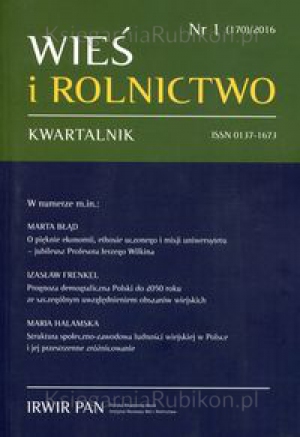Zarządzanie obszarami Natura 2000 w Polsce w kontekście zrównoważonego rozwoju wsi – aktualne wyzwania i konflikty
Management of Natura 2000 sites in Poland in the context of sustainable development – current challenges and conflicts
Author(s): Joanna Cent, Małgorzata Grodzińska-Jurczak, Agata Pietrzyk-Kaszyńska, Justyna GutowskaSubject(s): Economy
Published by: Instytut Rozwoju Wsi i Rolnictwa Polskiej Akademii Nauk
Keywords: Natura 2000; public participation; management plans; nature conservation; sustainable development; Natura 2000; partycypacja publiczna; plany zadań ochronnych; zarządzanie ochroną przyrody
Summary/Abstract: The sustainable development of rural areas could be based on multifunctional characteristics of locality according to various values, including natural and biological values. Areas with high values are often included in conservation programmes and the network of protected areas, such as Natura 2000. Very often these values are perceived as obstacles rather than opportunities for local development. In the case of Natura 2000, there have been a number of social conflicts in recent years hindering not only the effectiveness of management practices (i.e. conservation of endangered species and habitats), but also making it difficult to benefit socially and economically from these sites. This paper presents the results of research on the current problems and challenges related to the level of acceptance and opinions of Natura 2000 of a key stakeholders’ group. It indentifies the main barriers and chances perceived by the stakeholders at a preparation phase for management plans for Natura 2000 sites. The study was conducted with 350 participants of workshops organised within the Natura Mission – LIFE+ program in all Polish voivodships between January and March 2013. The results show that although respondents perceive Natura 2000 as potentially enhancing local development (mostly in respect to ecotourism sector), they still identify barriers stemming from Natura 2000 implementation that result in a negative attitude of local communities. Respondents also suggested the need for wider public participation in the setting up of management plans. If the management of Natura 2000 is to support local development, there is a need for better education about the programme, more engagement of local stakeholders and better economic support for the groups whose activities and wellbeing are affected by the protected areas.Zrównoważony rozwój obszarów wiejskich powinien opierać się na wielofunkcyjności oraz wykorzystaniu różnych walorów wsi, w tym również tych naturalnych. Przyrodniczo cenne obszary objęte programami ochrony, takimi jak Natura 2000, bardzo często postrzegane są jednak jako bariery, a nie czynniki potencjalnie wspierające rozwój. W ostatnich latach wokół obszarów Natura 2000 narosło wiele konfliktów, utrudniających nie tylko realizację zadań ochronnych, lecz także wykorzystanie możliwości, jakie ten program stwarza dla rozwoju lokalnego. Niniejsza praca przedstawia wyniki badań nad poziomem akceptacji i opinii kluczowych grup interesariuszy oraz problemami związanymi z funkcjonowaniem programu Natura 2000 podczas przygotowywania planów zadań ochronnych. Badania przeprowadzono wśród 350 uczestników jednodniowych szkoleń nt. programu Natura 2000 przeprowadzonych we wszystkich województwach w Polsce w okresie od stycznia do marca 2013 roku. Wyniki wskazują, iż pomimo dostrzegania przez respondentów wykorzystania Natury 2000 jako atutu w rozwoju lokalnym (głównie w sektorze turystycznym), to wciąż bariery inwestycyjne są główną przyczyną obaw i negatywnych opinii na jej temat. Ankietowani widzą także zdecydowaną potrzebę zaangażowania szerszego niż dotychczas spektrum interesariuszy w proces zarządzania takimi obszarami i pogłębienia dialogu pomiędzy nimi. Aby zarządzanie obszarami Natura 2000 szło w parze z rozwojem obszarów wiejskich, potrzebne jest rzeczywiste przyswojenie wiedzy o programie oraz zaangażowanie samorządów gminnych i innych interesariuszy w przygotowanie planów zadań ochronnych, a także realne wsparcie grup ponoszących koszty programu.
Journal: Wieś i Rolnictwo
- Issue Year: 168/2015
- Issue No: 3
- Page Range: 91-106
- Page Count: 16
- Language: Polish

